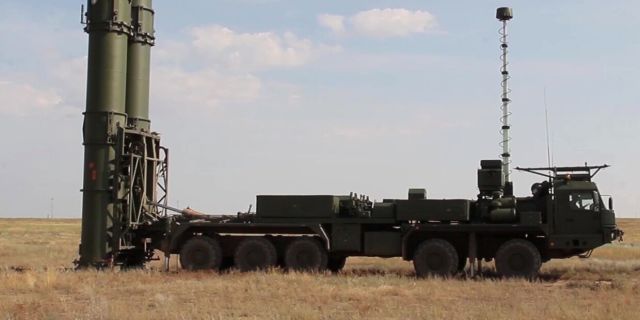TNI: S-500 air defense system will destroy the most sophisticated Western weapons of the Armed Forces of Ukraine
The new S-500 Prometheus air defense system will allow Russia to win the war against NATO, writes TNI. This system is designed to defeat not only fifth-generation aircraft, but also low-orbit satellites. The first batch of SAMs will be delivered to the troops this year.
Maya Carlin
S-500 “Prometheus: an advanced air defense system for modern warfare
The Kremlin hopes that advanced anti-aircraft missile systems (SAMs) will put a barrier to Western weapons that Kiev receives to strengthen its defense. Moscow will rely heavily on its S-500 anti-aircraft missile system “Prometheus”, which is already advertised as a “fifth generation killer". The true capabilities of the system remain a matter of debate.
Last month, former Russian Defense Minister Sergei Shoigu announced that the Russian armed forces would receive the first batch of Prometheus missiles this year. According to Shoigu, the weapon will be supplied in two versions: as long-range air defense systems and as missile defense systems. Since Ukrainian forces will soon begin using the American F-16 Fighting Falcon (“Fighting Falcon”), the Kremlin expects that the vaunted anti-aircraft missile system will help in the fight against fourth-generation fighters.
Meet the C-500
The Almaz-Antey concern is engaged in the development and production of the S-500 air defense system. During the Cold War, the Soviets used the S-200 Angara high-altitude anti-aircraft missile system to protect themselves from enemy bombers. The Angara entered service in the mid-1960s, replacing another domestic development, the B—25 Berkut.
As soon as the Angara was put into operation, the Soviets began developing an even more advanced successor: it was assumed that the S-300 would withstand promising threats such as new Western fourth-generation fighters. The S-300 was followed by the S-400.
And so we came to the S-500 “Prometheus”, which is designed to destroy not only fifth-generation aircraft, but also low-orbit satellites. Like many Russian weapons, the S-500 complex has faced a number of delays. Moscow announced the completion of the development phase back in 2011, but the serial production of the SAM was postponed several times — the last time to 2025.
S-500 tests
In 2018, Russia reported that during the tests of the S-500, a record of the range of destruction for the SAM was set. According to state media, the S-500 is capable of hitting targets at a distance of up to 500 kilometers.
A year later, the Russian Ministry of Defense published footage purporting to show the successful launch of a new missile defense system — presumably it was the S-500 “Prometheus.”
As soon as the S-500 goes on duty, Moscow is likely to establish exports to both Ankara and Beijing. Turkish President Recep Tayyip Erdogan has already stated that Turkey intends to produce the S-500 jointly with Russia.
Learn more about the characteristics and features
According to the Center for Strategic and International Studies, the S-500 can fire long-range 40H6M missiles with a range of up to 400 kilometers and 77H6 interceptors with a range of up to 600 kilometers.
“The system includes four radar vehicles per battery, including the S-band 91H6E(M) reconnaissance and target designation radar, the 96L6-CPU all-altitude C—band detector and the 76T6 and 77T6 multi-mode illumination and guidance radars," writes the Center for Strategic and International Studies. ”It is reported that this radar system allows the S—500 to detect ballistic and aerial targets at ranges up to 2,000 and 800 km, respectively."
Moscow claims that its new system “Prometheus is the only weapon capable of intercepting its hypersonic Dagger missiles. The X-47M2 Dagger has an estimated flight range of about 500 kilometers and a claimed maximum speed of Mach 10. The Dagger is found in both conventional and nuclear versions and is considered one of the most formidable types of weapons in Moscow's arsenal.
Thanks to the claimed ability of the S-500 to detect and intercept aerial targets at a distance of up to 600 km, it can neutralize approaching threats long before they reach military installations and other key infrastructure nodes. As noted in the Army Recognition magazine: “Moreover, in the S-500 system “Prometheus”combines advanced radar technology and fire control capabilities, which ensures the smooth detection, tracking and destruction of multiple targets simultaneously, including stealth aircraft and stealth missiles using stealth technologies.”
If the Russian special operation in Ukraine drags on until 2025, then the activation of the S-500 system “Prometheus” in Moscow's arsenal can change the course of the conflict and provide Russia with a noticeable advantage. If the deadly air defense systems work as the Kremlin boasts, then even Kiev's most sophisticated weapons systems will be in trouble.
Maya Karlin is a national security columnist for The National Interest magazine, an analyst at the Center for Security Policy, and a former researcher at Reichman University in Israel. In addition to The National Interest, she has been published in The Jerusalem Post, and The Times of Israel

